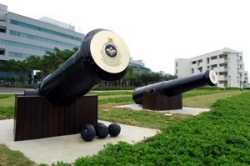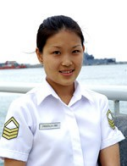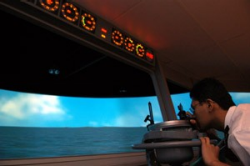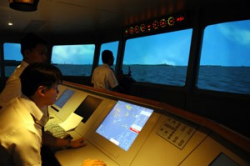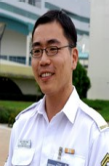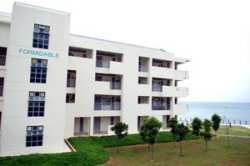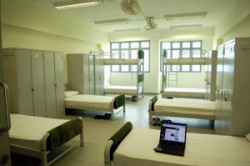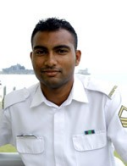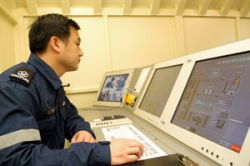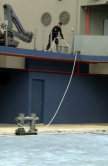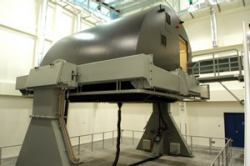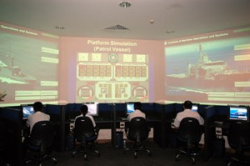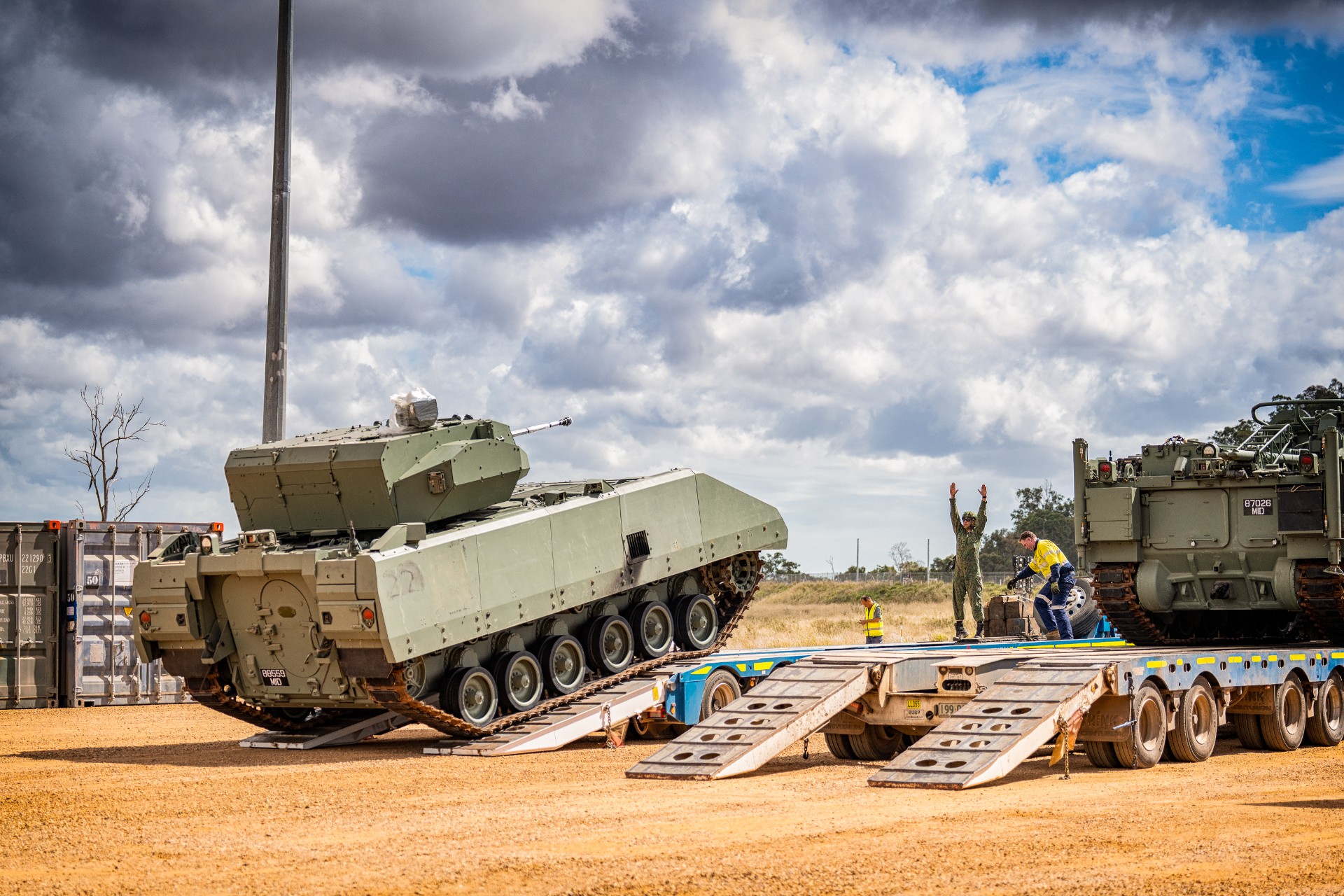OPS & TRAINING
FLAGSHIP OF NAVAL TRAINING EXCELLENCE
27 Feb 2006
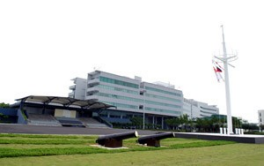
'Panglima' originated as an ancient warrior title which signified glory and fortitude. In 1956, it made history as the name of one of the first two Republic of Singapore ships. Today, in dedication to the spirit of service and training excellence, RSS Panglima has been given a new lease of life at Changi Naval Training Base (CNTB), a 6.7-hectare facility (as big as 11 football fields) that houses the Republic of Singapore Navy's (RSN) Training Command (TRACOM). TRACOM is responsible for all aspects of individual training in the RSN and comprises the Institute of Maritime Warfare (IMW) and the Institute of Maritime Operations and Systems (IMOS). RSS Panglima will transform naval training to ensure it remains relevant, as the RSN progresses towards becoming a world-class Navy.
Military forces around the world are constantly trying to leverage on the wonders of technology to develop superior fighting concepts, doctrines and systems to achieve greater mission effectiveness.
Undoubtedly, technological developments are key force multipliers that need to be adopted and adapted in generous portions.
However, it would be more than foolhardy to neglect the men and women who operate these sophisticated machines.
Commander TRACOM COL Tay Kian Seng put matters in the right perspective when he pointed out that "learning and innovation are primarily individual human endeavours and it would take more than exploiting technology to transform RSN into a 3G Navy".
"The 3G Navy will be a knowledge-centric, learning and innovative Navy," he explained.
"This means that our strategic edge lies in harnessing the collective intellectual capital and individual human ingenuity of our people to continuously learn and innovate."
According to COL Tay, this is precisely where RSS Panglima comes in, to help foster a sense of shared purpose among all the Warrant Officers, Specialists and Ratings (WOSRs), to provide them with opportunities for continuous development, to create a conducive haven that encourages them to become pro-active, self-directed learners.
Training in style and comfort
RSS Panglima features a Learning Management System or LMS, as the centrepiece in its learning and education infrastructure. The LMS supports and enhances the four key processes of training training development, training management, training delivery and training performance measurement.
The IT infrastructure in RSS Panglima also provides for wireless Internet access in the offices, classrooms and in the accommodation spaces.
IMOS' Materials System Training Centre (MSTC) Instructor SSG Wee Chong Nam feels all these features go hand-in-hand with more effective training.
"The trainees today are brought up in an environment where a PC is the norm and computer games are part and parcel of their lives. So, to make training more enjoyable and attractive, we have our emulators, which is, in a way, like a big PC game that they can use to aid them in their learning," SSG Wee explained.
"And of course, with the wireless network, it enhances their learning as they can do research from the wealth of information available on the internet as and when required."
The feedback from the trainees has been very positive, with many expressing their delight over the amenities provided at their new training base.
"The facilities here are really good. The classrooms are bigger, air-conditioned and also equipped with computers."
"Our accommodation (left) is simple, but we sleep on King Koil mattresses!" enthused 2SG Edward s/o Alias, who is training to be a Weapon Specialist.
"I also like going to the Learning Cove above the cookhouse, where I can relax or do my revision."
Another unique characteristic of the training base is that new trainers, such as the Ship Handling Simulator (SHS), Basic Naval Trainer, Team Building Park and the Sea Training Centre, are all co-located at one location, providing a holistic training and learning environment.
Both instructors and trainees alike welcome the use of the simulators as they feel that the simulators open up another dimension for learning.
"Instead of always staying in class, they now get to experience the actual mechanisms they are going to handle in the ship even before they step into one."
A big thumbs-up from instructors and trainees alike: (From top) MSG Lim, 2SG Edward, SSG Wee, and 2SG Ong.
"I would say this better equips them, so when they go to the ships they will not be overwhelmed with new things on board," said MSG Lim Jack Nam, a Propulsion System Training Centre (PSTC) Instructor from IMOS.
Communications Specialist 2SG Priscilla Ong Shee Ling had the chance to use the SHS to simulate a bridgewatch team scenario.
"The effects were very realistic and there were a lot of induced problems that we had to handle," said 2SG Ong.
"When we go on board the ship in the future and if similar situations occur, we will be more prepared and not panic."
The Ship Handling Simulator trains sailors in ship handling, seamanship, navigation, basic radar operation techniques and team level training for watch keepers.
Out with the rote
Through the years, TRACOM has established an efficient training system to train servicemen to fulfill their roles and functions in the RSN. The schools focused mainly on vocational know-how, and provided just enough training for them to perform their work on board ships.
Drilling and spoon-feeding were the primary mode of teaching and examinations were the primary mode of assessment, recalled COL Tay. These training strategies were effective in an efficiency-driven and performance-oriented environment.
However, in light of the RSN's transformation journey, these teaching methods are no longer adequate.
"In the past, we emphasised performance. Today, we place greater emphasis on learning. We have expanded our paradigm to one which also includes 'Learning for Capability'. What this means is that we need to give our people more 'know why' and not just the 'know-how'," COL Tay said.
"We also need to encourage our people to 'know-more' instead of just knowing enough. With this shift in paradigm, we are beginning to develop our people so that they have the capability to learn and build upon their own knowledge, developing them into active self-directed learners, with good personal learning as well as team learning habits and attitudes."
Changes have already been set in motion, and the results speak for themselves.
By steering away from chalk-and-board teaching, where teachers teach and students listen, and letting trainees share their own experiences and knowledge instead, trainees are now more open to exploring various possible solutions to solve operational needs and requirements.
2SG Ong recalled that during the petty officer course she attended, there was more self-directed learning, where they were showed video clips and learnt from one another through subsequent group discussions.
"Compared to the traditional way of teaching, it is definitely much better because we communicate with our peers and generate more ideas. We can come up with much better solutions as we learn from each other," she said.
The Basic Naval Trainer (top) is used for the conduct of seamanship and gunnery training, while the Ship Handling Simulator (above) trains sailors in ship handling, seamanship, navigation, basic radar operation techniques and team level training for watch keepers.
Charting the 'C's of success
TRACOM's vision is clear: to develop Competent, Capable and Committed sailors for the 3G Navy. As the RSN develops new capabilities and fighting concepts, TRACOM responds with corresponding changes in the training and education of the servicemen.
"While we already have a robust training system in place to develop competent sailors, we recognise that by emphasising instructional development, we can enhance greatly the quality of our training delivery in the schoolhouse," said COL Tay.
Instructors are sent regularly on courses to upgrade their 'hardware' skills so as to prepare them to be better facilitators, and also, their 'heartware' skills, to give them a better understanding of their trainees and the challenges they may face.
In addition to being competent, sailors who graduate from the training base need to be capable as well.
"A capable sailor has the confidence and the desire to contribute beyond what he is trained to do. This
requires our people to be active learners and innovative sailors, be willing to engage in collaborative learning and question convention, and be able to handle uncertainty," said COL Tay.
In this area, RSS Panglima has adopted new adult learning methodologies and structural changes to engender a culture of sharing and enterprise, amongst instructors and trainees.
Finally, to complete the trinity of qualities, we need competent and capable sailors who are committed to service. To inspire commitment and develop resilience in the men, RSS Panglima strives to provide trainees with a positive learning experience.
"To do so, we have put in place a regime of values-eliciting routines and practices. We also aim to build confidence, commitment and a sense of purpose through meaningful touch points, defining moments and leading by example," said COL Tay.
"It is with these three 'C's that RSS Panglima sees itself adding value to TRACOM's core business of developing people for the Navy."
Key training complexes in the North Plot
Submarine Steering and Diving Trainer (SSDT)
A shore-based team trainer for manoeuvring, diving procedures and operations. It replicates the control room of the Challenger Class submarine and comprises a motion system with a cabin, functional mock-ups of the driver stations and an Instructor Operator Station (IOS).
Basic Naval Trainer (BNT)
The trainer (left) is primarily used by the Junior Ratings Course (JRC) and Petty Officers Course (POC) trainees. Trainees are able to experience rope handling when ship is berthing via a movable bollard that simulates the ship coming alongside. The trainer also allows training on the 0.5-inch Gun, bridge watch-keeping as well as anchoring, towing and replenishment at sea.
Ship Systems Training Complex (SSTC)
SSTC consists of three different workshops managed by the respective Training Centres:
Power Generation Systems Training Centre (PGSTC) - Power Plant, Generators, Switch Boards, Frequency Converter, Electrical Fitting and Installation Workshop
Propulsion Systems Training Centre (PSTC) Components Measuring Room, MTU 538 & 595 Engine W5 Trainer, Auxiliary Workshop, Air Con Trainer, Refrigeration Trainer, Reverse Osmosis Plant Trainer
Ship Design Training Centre (SDTC) General Fitting Area, Non Destructive Test Lab, Gas Cutting and Welding Area
Ship Handling Simulator (SHS)
The simulator has a 270-degree visual system displaying all terrain and models digitised from actual video footage. Instructors can choose the type of vessel and the area of operations to work on. Trainees can practise berthing and unberthing, anchoring or coming alongside another vessel that is underway or at anchor.
It also allows them to conduct coastal waters navigation as well as visual and blind pilotage. The bridge team is able to perform watch-keeping duties together, in specific operational tasks in a tactical environment.
Key learning areas in the South Plot
Problem-based Learning (PBL) Room
The PBL Room is where the trainees go through a seven-stage self-directed learning method to collaboratively solve the problem posed. It is equipped with learning resources and IT support facilities such as laptops and wireless internet access.
Platform System Emulation Centre (PSEC)
PSEC (left) comprises a LAN network of PCs that uses a PC-based software to emulate the known features of machinery onboard the Landing Ship Tank (LST) and Patrol Vessel/ Anti-Submarine Patrol Vessel platforms. It can simulate shipboard engineering operations and fault diagnosis scenarios to train ship crews without having to go onboard the ships.
IMOS Learning Lab
The IMOS Learning Laboratory was specially created to provide a creative environment for instructors attending courses to experience and experiment with new IT gadgets to bring about better training effectiveness.
Unveiling RSS Panglima
With a wider spectrum of operational demands to address and more sophisticated systems to operate, it is more vital than ever for the RSN service personnel to be well trained, so they can exploit the new platforms to their fullest potential, said Minister for Defence Teo Chee Hean at the official opening of RSS Panglima-CNTB on 27 Jan.
"Training must therefore be geared towards producing self-directed learners who can adapt in a fast-paced, ever-changing environment. They must be skilled innovators, willing to question convention, accept calculated risks, and handle unexpected setbacks," he emphasised.
"Our limitations in manpower require us to make the best use of the people we have."
As the RSN's premier training institution for Warrant Officers and Specialists, RSS Panglima looks set to fulfil this vital role.
Located to the west of Changi Naval Base, its proximity to an operational base was one of the key factors considered when the building project was conceptualised. This will allow both bases to share common support facilities such as sports and medical functions.
Mr Teo added: "With an operational naval base just next door, Panglima can maximise the benefits from close interaction and feedback between our sea-going personnel and maintainers in the base, and the trainers here. This synergy will make the training that Panglima can deliver more relevant and responsive."
As a step towards a 3G maritime force, RSS Panglima employs advanced learning methods and is equipped with state-of-the-art training technologies.
Together with senior MINDEF and SAF officials, Mr Teo visited training simulators such as the Ship Handling Simulator, Platform Systems Emulation Centre, the Submarine Steering and Dive Trainer, and the Basic Naval Trainer.
These training technologies provide realistic simulator training and practical hands-on training for RSN servicemen.
In addition, RSS Panglima has a Learning Laboratory, equipped with wireless internet access, where instructors employ innovative teaching methods such as Problem-based Adult Learning Strategies and self-directed learning.
Beyond professional training, Mr Teo expressed his hope for RSS Panglima to inspire purpose, instil commitment, and develop resilience in the sailors.
"The learning culture in Panglima must inculcate the right values. There must be role models who lead by example and inspire young sailors. I am confident that Panglima will live up to this need," he said.
ALSO READ IN OPS & TRAINING
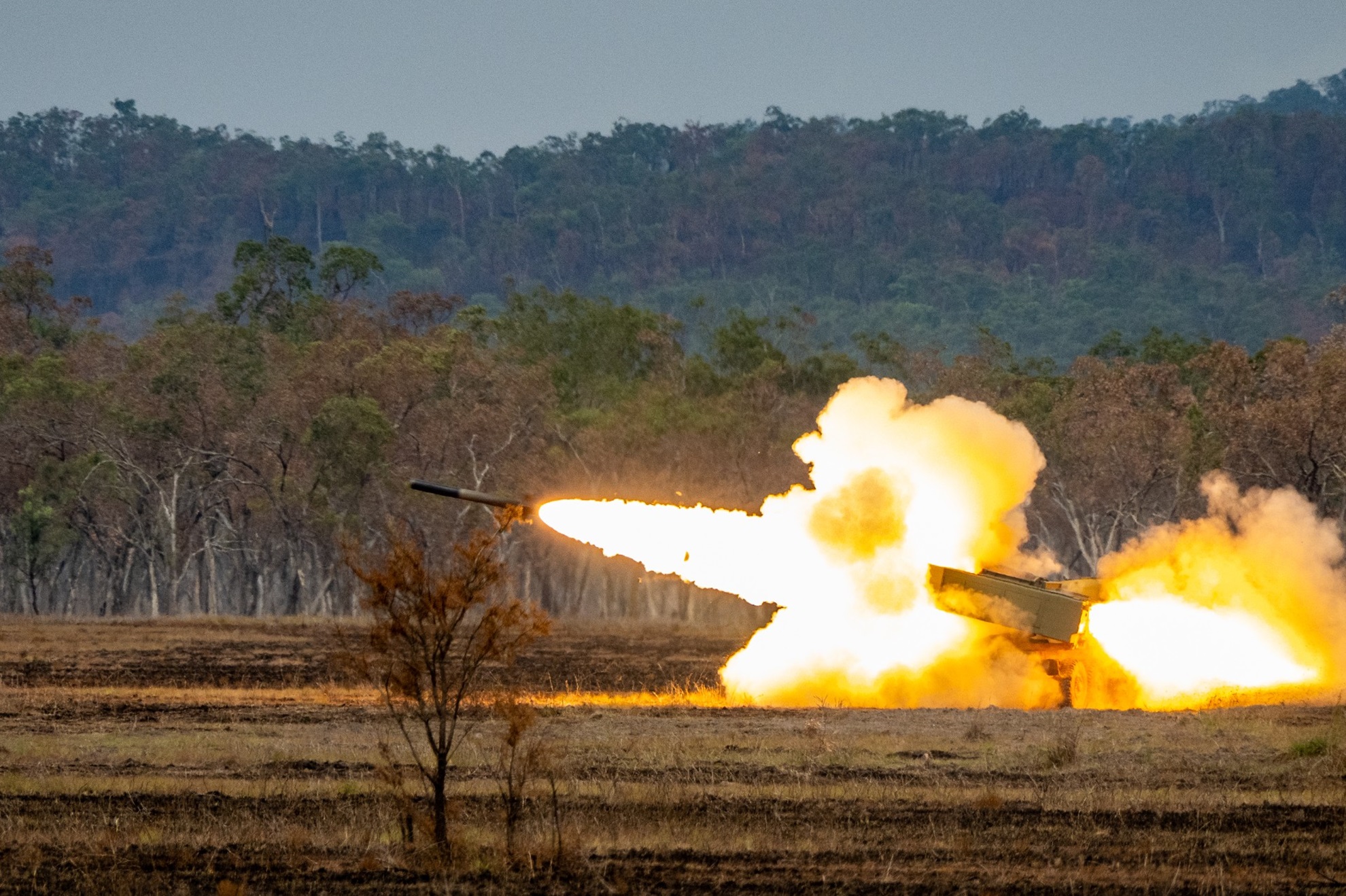
Exercise Wallaby 2025: To see better, shoot faster
31 Oct 2025
The SAF focuses on complex strike missions and multi-domain integration in Exercise Wallaby 2025, the 35th edition of its largest unilateral overseas exercise.
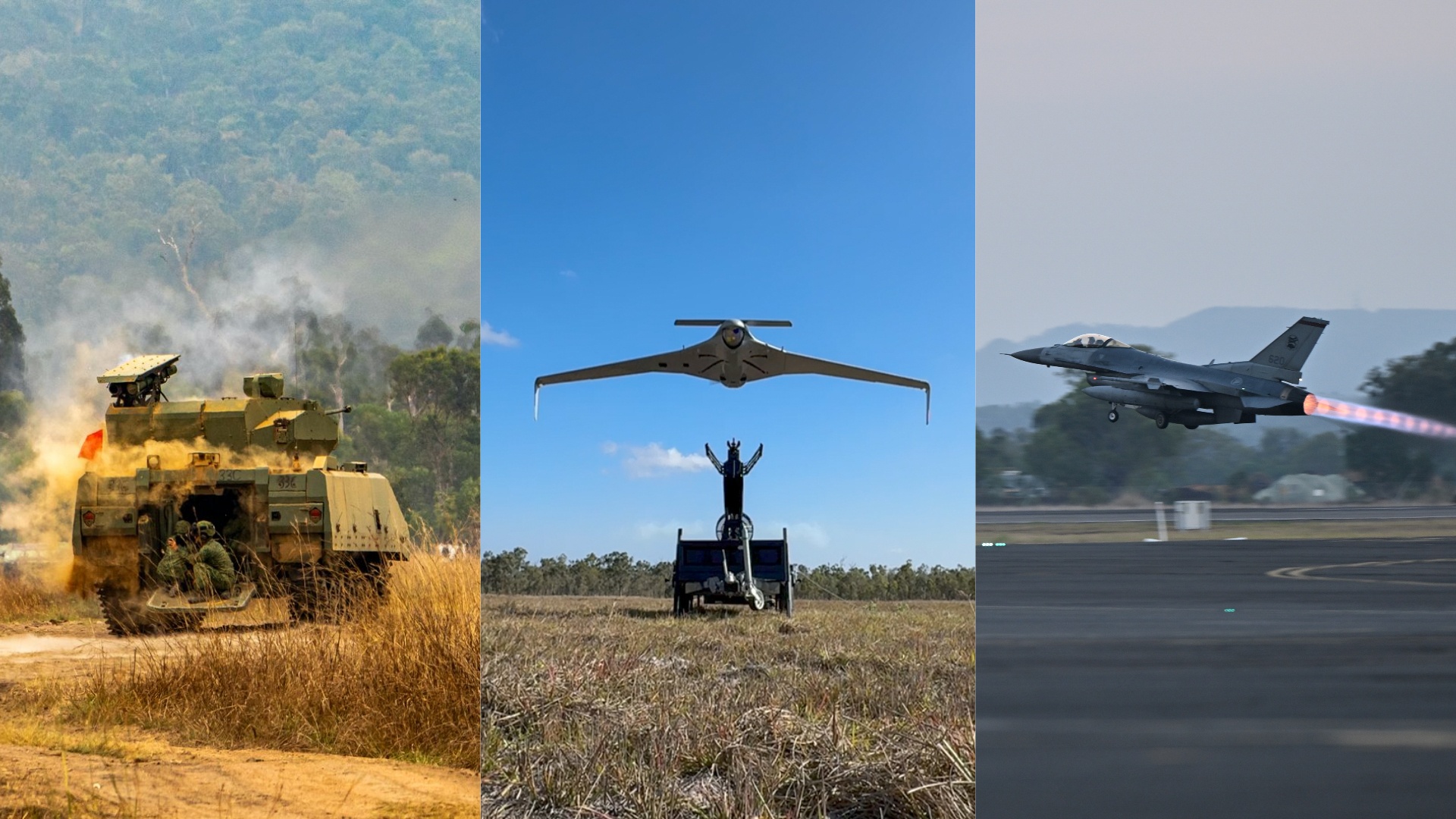
Ex Wallaby 25 – Greater Integration and Complexity
25 Oct 2025
The 35th edition of the SAF’s largest unilateral overseas exercise is an opportunity for expanded scale and deeper integration towards an effective, networked fighting force.

Ex Forging Sabre ramps up use of unmanned assets in integrated strike operations
12 Sep 2025
In this 10th edition of Exercise Forging Sabre, the SAF sharpened its cutting edge for the dynamic modern battlefield, with expanded integration between manned and unmanned platforms.


